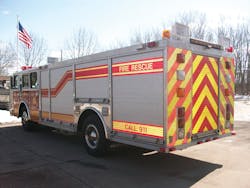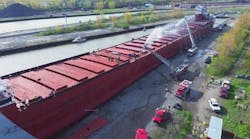Prior to the introduction of stainless steel and aluminum apparatus bodies, fire departments contended with steel body deterioration — rust. The chipping and damaging of painted surfaces exposed ferrous metal to the elements. Manufacturers initially addressed the problem by offering optional aluminum and steel scuff plates. Bright finished stainless-steel and aluminum replaced painted steel fenderettes and treadplate was provided in wheel-well panels — both areas prone to paint damage. Manufacturers began offering treadplate rear step compartment doors. The introduction of non-ferrous metallic bodies lessened the requirement for paint protection, but did not eliminate body deterioration.
The phenomenon known as electrolysis or galvanic corrosion can be problematic with all metallic bodies. To quote one supplier of thermal and moisture protection: "Electrolytic corrosion (electrolysis) occurs when dissimilar metals are in contact in the presence of an electrolyte, such as water (moisture)…and the dissimilar metals set up a galvanic action that results in the deterioration of one of them." The metals include aluminum, steel, brass, copper, nickel, and the 300 and 400 series of stainless steel.
The 1980s and '90s saw design features and product improvements that led to the non-intentional introduction of totally unpainted bodies, primarily those equipped with roll-up (shutter) compartment doors. When introduced, roll-up doors were not painted. Aluminum and stainless bodies were offered featuring unpainted interior hosebed side sheets and compartment interiors. Unfinished aluminum hosebed dividers replaced those of painted steel.
Meeting the Needs Of Departments
Responding to purchasers' requests to maximize storage space, manufacturers designed equipment compartments with larger door openings. Compartment headers and door jambs were made smaller, increasing the usable door widths and heights. (The header is that portion of a compartment above the actual door opening and the door jamb is the area from a compartment's side wall to the door opening — both notoriously inaccessible storage spaces.)
The design resulted in less visible surface area requiring painting. The painted sides of running board compartments facing both the pump panels and the rear of the apparatus were susceptible to damage and manufacturers started installing treadplate on those front and rear exterior vertical panels. Wrapping the treadplate around those vertical compartment corners to the leading door edges afforded additional protection. Compartment tops, constructed of or capped with treadplate, could also be wrapped over the top to the leading door edges. Pumpers, especially those featuring multiple rear inlets and discharges, found painted rear body panels subject to extraordinary wear and using all treadplate in this area negated the problem. Concurrently, the fabrication of aluminum and stainless steel pump houses and supplying stainless or vinyl covered pump panels virtually eliminated all paint in the pump house area.
Purchasers should note that apparatus with painted bodies may be supplied with unpainted pump modules and vice versa. Read or write your specifications carefully. By design, manufacturers today are offering unpainted bodies. In response to a questionnaire, Rosenbauer America has marketed unpainted bodies for over a dozen years; HME Ahrens-Fox has been doing the same for eight years and Smeal has started within the past year.
Paint liftoff, a headache for any apparatus manufacturer, is a non-issue with non-painted bodies. Liftoff, commonly called but not always caused by electrolysis, occurs when moisture penetrates the paint and primer to the surface of the body. If a hole is drilled in a painted surface to mount an accessory such as a light or door handle and the hole is not properly sealed, road wash and particularly road salt, can work its way between the paint and the base metal — regardless of its composition. The paint may blister or bubble, then peel off in large pieces. To prevent this, manufacturers usually pre-drill and install, then remove bolt-on or screwed-on accessories before painting. Ensure that the requirement is in your specifications. Granted, there could be an occasional problem with a particular paint product or process; however, read your paint warranties carefully. End users may have a written obligation to perform paint maintenance for normal wear and tear.
Electrolysis, the real nightmare to manufacturers, can occur with almost any type of metal body. Stainless steel and aluminum are as susceptible as treated and untreated steel bodies. Moisture is the culprit, creating a conduit between dissimilar metals and causing corrosion. Stainless hinges on aluminum bodies and aluminum accoutrements on stainless bodies are prime areas for electrolysis. Aluminum treadplate appliques sandwiched against unfinished aluminum or stainless may suffer electrolysis if not adequately isolated. To prevent electrolysis, manufacturers isolate dissimilar metals with corrosion-resistant barriers. Whether the corrosion barrier be a solid gasket, Mylar film, tape or a liquid that is brushed on, sprayed on or squeezed on is a topic best left to the vendors. Ask them what they use and why.
Polypropylene (poly) and composite (fiberglass) bodies, being non-corrosive, are not subject to electrolysis. Non-painted poly booster tanks have been used extensively for years; however, a track record has yet to be established for painted poly bodies. Laminated fiberglass construction utilizes a gelcoat to seal the resin and fiberglass laminates prior to painting. Domestic use of composite bodies is also relatively new and, as such, it is unknown whether chipping or gouging the paint completely through the gelcoat will affect paint adherence. However, it is important to note painted composite bodies have seen extensive use in Europe for decades.
Careful Assembly Is Required
Painting not only protects metals, but covers a multitude of sins such as weld burns, mars and scratches made during fabrication; consequently, unpainted bodies require careful assembly. Many unpainted compartment interiors have brushed or swirled finishes, allowing easy and inexpensive touch-up in the field. An obvious benefit in not painting a body is a cost savings. The manufacturers report saving between $6,000 and $10,000 in the initial purchase price. Labor, primer, paint and the cost of a paint warranty is eliminated. There is additional cost in using some non-corrosive materials and actual savings will vary.
Jeff Wegner, regional sales director for Smeal Fire Apparatus, noted a hidden saving is in the build process. "We no longer have to build the apparatus twice," he said. "We currently build the truck 100% in the fabrication line and then completely dismantle it to paint it, then reassemble the complete unit."
A benefit for the purchaser is not performing continuous paint maintenance and possibly having to repair and repaint an entire apparatus body. Should paint deterioration require an in-service pumper body to be stripped, repainted and reassembled, the cost could be as high as $40,000. Unpainted metallic apparatus bodies have been in service for many years with few problems with electrolysis and, obviously, none with paint liftoff.
The European fire service has a pragmatic view of its fire apparatus — they are considered utility vehicles. Some domestic users consider fire apparatus bodies as pieces of art that should be appropriately adorned. Others make social statements with the paint process. Traditionalists adamant for color on their apparatus can specify painted roll-up doors or extra reflective striping.
Dave Fornell, sales and marketing manager for HME Ahrens-Fox, notes an increased trend for unpainted bodies with painted roll-up doors. When introduced, painted roll-ups were notorious for paint chipping, but manufacturers seem to have the problem under control. Painted roll-up doors cost about $300 more than the brushed finish. Manufacturers can also provide removable individually painted panels of composite or metal on visible areas of the body. Polished and mirror finished trim appliques are regularly used in lieu of paint.
Mike LeMieux, engineer for the General Division of Rosenbauer America, said there are rarely any electrolysis/corrosion problems with treadplate or decorative appliques attached to unfinished bodies and "aluminum treadplate is the normal exterior material which deteriorates due to road salt." HME's Fornell also made note there are many different alloys of stainless steel: "So, while a manufacturer offers 'stainless-steel' construction, depending on the alloy used, it may have to be painted for optimum corrosion protection." It may be prudent to require vendors to supply a body-material specification sheet when submitting a proposal.
Ask About Cost Differences
When specifying a new apparatus, ask the vendors the cost difference between painted and unpainted bodies as well as between painted and unpainted compartment interiors. Ditto for the pump house. A paint warranty for an unpainted apparatus body is obviously not necessary; however, who warranties electrolysis damage to an unpainted body and its accoutrements? Somebody should. Ask and include it in your specifications.
This commentary is not an indictment of painting nor does it promote unpainted bodies. Accidental damage to painted surfaces with subsequent metal corrosion as well as improper paint maintenance is not necessarily the fault of the paint manufacturers or the apparatus builder. It has, however, been the source of numerous unwarranted warranty claims. Properly prepped and painted metal surfaces have protected fire apparatus for years — and has made them look good — and will continue to do so in the foreseeable future.
—William F. Adams







